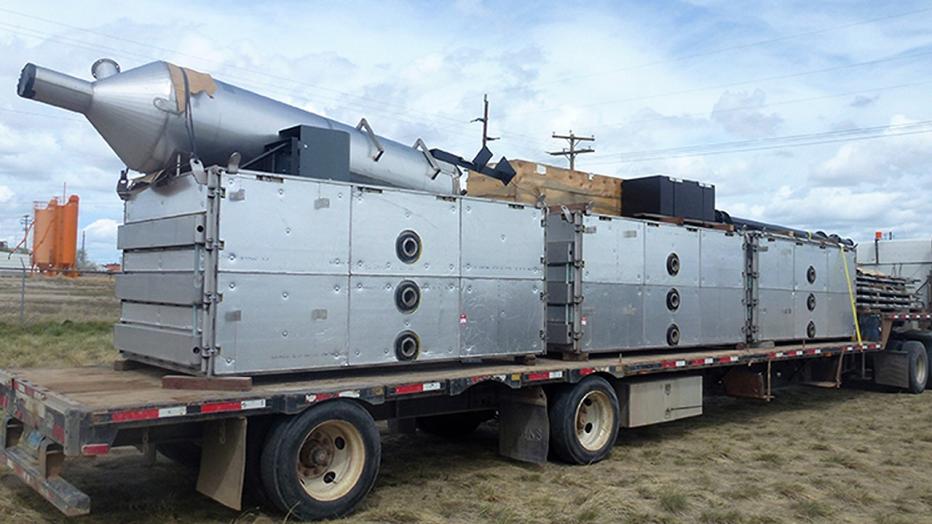
Advancing the science for treating Per- and polyfluorinated alkyl substances (PFAS), Jacobs’ Principal Hydrogeologist and Emerging Contaminants Leader Bill DiGuiseppi discusses the company’s recent bench scale test results for thermal desorption of PFAS from aqueous film forming foam.
Working ahead of regulatory requirements, our Emerging Contaminants team at Jacobs has partnered with clients, academic partners and remediation vendors for more than five years to develop and test methods for treating PFAS.
Although there are hundreds of individual PFAS, the most commonly encountered in environmental media are perfluorooctanoic acid (PFOA) and perfluorooctane sulfonic acid (PFOS). PFAS have unique surfactant properties that make them repel both water and oil. They have been used extensively in surface coatings and protective formulations for paper and cardboard packaging products, carpets, leather products and textiles, as well as industrial surfactants, emulsifiers, wetting agents, additives and coatings.
Aqueous film forming foam (AFFF), another source of PFAS and the focus of our most recent treatment and mitigation investigation, was designed to quickly extinguish flammable liquids and was in common use at facilities at risk for petroleum fires. PFAS were released to soil, sediment, surface water and groundwater at fire training areas, fire stations, storage facilities, hangers and emergency response locations around the world.
Why are PFAS a concern?
PFAS have been found in almost all human blood samples collected worldwide. Some PFAS, such as PFOS, bioaccumulate and biomagnify in wildlife species such as fish and fish-eating birds. In animal studies, some PFAS disrupt normal endocrine activity, reduce immune function, cause adverse effects on multiple organs, including the liver and pancreas, and cause developmental problems in rodent offspring exposed in the womb. Low birthweight babies and elevated cholesterol have been linked to elevated PFAS in human blood, and health studies have linked firefighter cancers to exposure at training facilities using AFFF.
In 2005, PFOA and PFOS were added to the list of 12 persistent organic pollutants—toxic chemicals that adversely affect human health and the environment—established at the 2001 Stockholm Convention. The following year, the European Union restricted PFOS use and manufacture of products containing PFOS. That same year, the eight major U.S. companies in the PFAS industry agreed to significantly reduce production of PFOA and associated compounds by 2010, and work toward elimination by 2015 under a voluntary agreement with the U.S. Environmental Protection Agency.
What can be done to treat or remediate PFAS?
Because of their persistence and lack of partitioning to air, PFOS and PFOA resist most conventional treatment technologies such as direct oxidation, biodegradation, air stripping, vapor extraction and UV photolysis. For extracted groundwater or drinking water, Jacobs has evaluated and/or successfully implemented several treatment technologies, including granular-activated carbon (GAC), anion exchange resin (AEX) and reverse osmosis (RO). We have also performed bench testing of several other treatment technologies, including oxidation and flocculation.
With the immediate need to treat impacted drinking water, source area soils have largely been ignored, although they represent a substantial and ongoing contribution to groundwater plumes. Several states have recognized this risk and have declared very low standards for soil to be protective of groundwater. For these reasons, it is likely that the industry focus will shift in the coming years toward the mitigation of PFAS in source area soils.
New thermal treatment study demonstrates effective removal of PFAS from soil
In collaboration with the Iron Creek Group’s VP of Operations Roger Richter and USACE Omaha District’s Project Geologist Michael Riggle, I recently published results from multiple bench-scale tests demonstrating that low temperature thermal desorption (LTTD) is a viable option for treatment of per- and polyfluoroalkyl substances in soil associated with AFFF impacts.
The temperature optimization studies utilized AFFF-impacted silty sand coastal plain soils from a US Navy installation, which included support from the US Navy LANTDIV, Battelle and SGS AXYS Analytical Services, Ltd. During the three separate bench tests, temperatures of 250 °C, 300 °C, 350 °C, 400 °C, 550 °C, and 700 °C were evaluated at heating times ranging from 50 minutes to eight days. The testing identified 350 °C as the lowest effective temperature, with 99.4 percent removal for the total of the 29 PFAS analyzed within two days at 350 °C, whereas only 40 percent total PFAS removal was observed at 300 °C over a four-day duration.
Longer heating durations did not improve removal at either temperature. Infrared heating for LTTD will be tested further during Jacobs’ on-going US Department of Defense-funded Strategic Environmental Research and Development Program (SERDP) research project aimed at utilizing a portable unit for on-site treatment of PFAS-impacted investigation derived waste.
A key to establishing the time-temperature relationship is that lower temperature, longer duration allows the flexibility to use not only batch thermal boxes but opens up the prospect of remediating excavated piles for larger scale soil treatment or implementing as an in-situ solution for areas where excavation is logistically difficult. Heating in situ source area soils to 350 °C is feasible and can be coupled with a soil vapor extraction system to capture the volatilized PFAS for destructive treatment.
Want to learn more about the study?
The Low Temperature Desorption of Per- and Polyfluoroalkyl Substances in Soils study is presented in the January-February 2019 Environmental Engineering edition of The Military Engineer, the publication of the Society of American Military Engineers (SAME).
About the authors
Bill DiGuiseppi is Jacobs’ Principal Hydrogeologist and Emerging Contaminants Leader, and serves as the Vice Chair for Emerging Issues on the National Environmental Committee at SAME and the Remediation Subgroup co-lead for the Interstate Technology & Regulatory Council (ITRC) PFAS Team. The authors would like to thank the following individuals for their support of this project and preparation of this article: Doug Simpleman and Paul Gedbaw of the U.S. Army Corps of Engineers Omaha District; Tim Fitzpatrick and Richard Grace of SGS AXYS Analytical Services, Ltd; and Jim Hatton, Scott Grieco, Katie Rabe and Tiffany Hill ofJacobs.












































